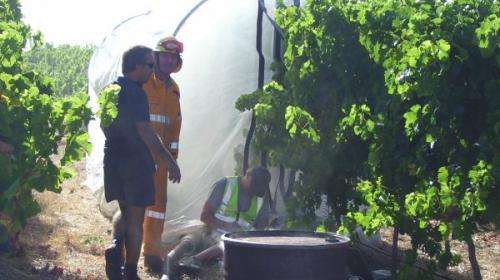Local firefighters work with scientists to study the effect of bushfire smoke exposure on grapes and wines. Credit: David Kelly
Winemaking methods influence the degree of smoke taint in wines made from smoke-exposed grapes, new research suggests.
Smoke taint can have a significant economic impact on winemakers in bushfire-prone areas, and its prevention could represent major savings for producers, with flow-on benefits for wine exporters and consumers.
Researchers at Curtin University's Margaret River Education Campus focussed on the complex chemical processes that smoke instigates in grapes.
"Wine grapes exposed to smoke from wildfires and controlled burns produce wines with an elevated concentration of volatile and glycoconjugated phenols," says Dr Ayalsew Zerihun.
The phenols cause unpleasant flavours and aromas, tasting burnt, smoky, medicinal and dirty, Dr Zerihun says.
"These wines have low consumer acceptance, which means significant economic impact for the industry."
Merlot scores high on phenol levels
The study examined the relationship between fruit exposure to smoke and the phenol levels in wine, identifying grape-processing and winemaking methods as the key driver in determining how much phenol made it into a wine.
The traditional method of red winemaking using skin contact released the highest phenol levels.
When making Merlot, for example, 88 per cent of grape phenols were released into the wine.
White winemaking methods produced far lower phenol concentrations, with crushing before pressing (Sauvignon Blanc) releasing only 39 percent of phenols, and whole-bunch pressing without crushing (Chardonnay) releasing just 18 per cent.
Through further testing researchers ruled out this difference being due to malolactic fermentation, a common technique in red winemaking that uses lactic acid bacteria to influence wine aroma complexity.
The type of smoke was also ruled out, as trials were replicated three to six times to test the effects of smoke from pasture grass and Monterey pine (Pinus radiata) respectively.
Nor was the type of grape, known as the cultivar, a factor.
"For the three cultivars evaluated, when exposure to smoke occurred at the same state of berry development, no significant cultivar sensitivity was observed in the accumulation of total phenols in grapes, although the phenol composition varied," Dr Zerihun says.
The findings have a direct and practical impact for industry.
"Our results provide practical guidelines on the likely proportion of grape phenols to be expected in the wines for the three traditional methods studied," Dr Zerihun says.
"This understanding can help grape growers and wine makers improve their decision-making abilities, thus helping to mitigate and manage smoke taint."
No doubt, wine drinkers everywhere will say 'here's cheers' to that.
More information: "Winemaking practice affects the extraction of smoke-borne phenols from grapes into wines." D. Kelly, et al. Australian Journal of Grape and Wine Research Volume 20, Issue 3, pages 386–393, October 2014. onlinelibrary.wiley.com/doi/10 … /ajgw.12089/abstract
Provided by Science Network WA























